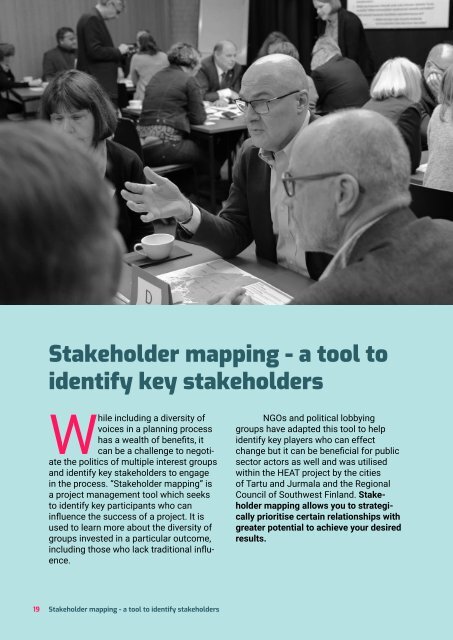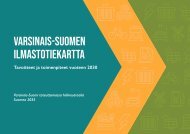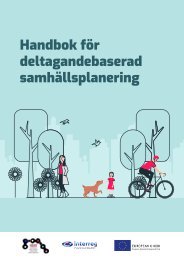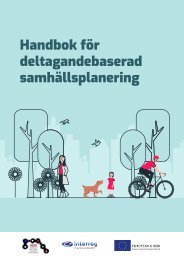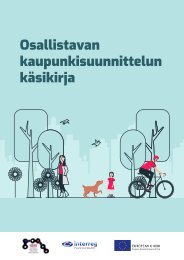Handbook for Participatory Urban Planning
This handbook is a result of an EU-funded project “HEAT - participatory urban planning for healthier urban communities”. For the last two years, the project partners from Finland, Estonia, Latvia and Sweden have worked with more inclusive and participatory processes with a focus on sustainable and healthy communities, particularly related to cycling. Nevertheless, the same principle charts the course, more or less, in any participatory process: you have a goal, and you are trying to find the best available paths to reach it. As the topic is not simple and the change is not happening overnight, we wanted to share our experiences and the knowledge gained during the project with the hope to help or inspire others trying to tackle similar issues.
This handbook is a result of an EU-funded project “HEAT - participatory urban planning for healthier urban communities”. For the last two years, the project partners from Finland, Estonia, Latvia and Sweden have worked with more inclusive and participatory processes with a focus on sustainable and healthy communities, particularly related to cycling. Nevertheless, the same principle charts the course, more or less, in any participatory process: you have a goal, and you are trying to find the best available paths to reach it. As the topic is not simple and the change is not happening overnight, we wanted to share our experiences and the knowledge gained during the project with the hope to help or inspire others trying to tackle similar issues.
Create successful ePaper yourself
Turn your PDF publications into a flip-book with our unique Google optimized e-Paper software.
Stakeholder mapping - a tool to<br />
identify key stakeholders<br />
How does it work?<br />
By placing your identified stakeholders<br />
on a two-axis grid, with<br />
influence and ability to affect<br />
change on one axis, and interest<br />
and passion <strong>for</strong> the subject represented<br />
on the other axis, you can more clearly<br />
visualise the actors in play and strategise<br />
<strong>for</strong> their support. The influence axis helps<br />
you to identify both highly powerful and<br />
influential actors, and also how other<br />
stakeholders correlate in their ability to<br />
affect change. The interest axis, on the<br />
other hand, is used to identify highly passionate<br />
stakeholders, and gauge influential<br />
stakeholders’ respective interest in<br />
the project at hand.<br />
Using this grid, it is easy to spot<br />
the stakeholders with both influence and<br />
interest in the outcomes one desires. It<br />
also highlights which actors have great<br />
influence but little interest, or those<br />
parties passionate about the subject but<br />
lacking in power to address that passion.<br />
Depending on what you seek to achieve,<br />
you can see this exercise as simply a<br />
mapping exercise to better understand<br />
and identify different types of actors. You<br />
can also use the task to not only map<br />
actors but also to identify how you can<br />
attempt to move actors along these respective<br />
axes to ensure a greater concentration<br />
of stakeholders who both share<br />
your interests and have the influence to<br />
help achieve your desired results.<br />
This method is also a valuable tool<br />
<strong>for</strong> those working more directly with planning<br />
processes. By identifying various<br />
groups of traffic users, including a diversity<br />
of sometimes conflicting interests<br />
among stakeholders with an interest in<br />
health-promoting transportation, one can<br />
identify key stakeholders important <strong>for</strong><br />
your planning process. These stakeholders<br />
can include politicians and business<br />
leaders, but also the interests of various<br />
traffic users. It can be useful to try<br />
to think outside the box when mapping<br />
stakeholders and identify actors who may<br />
be less well-known to you or who you do<br />
not often engage with. Another valuable<br />
strategy is to include ongoing initiatives<br />
and processes alongside individuals and<br />
organisations to map a broader swath of<br />
society.<br />
While including a diversity of<br />
voices in a planning process<br />
has a wealth of benefits, it<br />
can be a challenge to negotiate<br />
the politics of multiple interest groups<br />
and identify key stakeholders to engage<br />
in the process. “Stakeholder mapping” is<br />
a project management tool which seeks<br />
to identify key participants who can<br />
influence the success of a project. It is<br />
used to learn more about the diversity of<br />
groups invested in a particular outcome,<br />
including those who lack traditional influence.<br />
NGOs and political lobbying<br />
groups have adapted this tool to help<br />
identify key players who can effect<br />
change but it can be beneficial <strong>for</strong> public<br />
sector actors as well and was utilised<br />
within the HEAT project by the cities<br />
of Tartu and Jurmala and the Regional<br />
Council of Southwest Finland. Stakeholder<br />
mapping allows you to strategically<br />
prioritise certain relationships with<br />
greater potential to achieve your desired<br />
results.<br />
DOWNLOAD:<br />
Template <strong>for</strong> stakeholder<br />
mapping (pdf)<br />
FIND OUT MORE:<br />
An example of<br />
a stakeholder map (pdf)<br />
19 Stakeholder mapping - a tool to identify stakeholders<br />
Stakeholder mapping - a tool to identify key stakeholders 20


